
Once a week, after she brushes her teeth and gets ready to leave for work at the Oklahoma Medical Research Foundation, Cindy Carter sets a 30-minute timer on her phone.
When Carter’s phone buzzes on her drive, it reminds her of the task that now kicks off her week: submitting a saliva sample for OMRF’s weekly employee Covid-19 testing program.
Before leaving her car, Carter opens her testing kit, which OMRF provides to staff members each week. Inside is a cup, a barcoded sample tube, pipette, alcohol wipe and biohazard bag.
“I don’t want to take off my mask indoors, so before I go in, I spit into the cup, put the sample in the tube and throw the waste away in a biohazard receptacle,” said Carter, a lab manager for OMRF’s Cardiovascular Biology Research Program.
Carter then enters OMRF’s Research Tower, where a human resources staffer sits behind plexiglass, ready to collect samples.
“They scan a barcode on my employee badge, then a barcode on the tube,” explained Carter, who joined OMRF in 1996. “Only human resources has those codes. It couldn’t be easier or faster.”
Each Wednesday morning, having collected samples from the 300-plus employees who are onsite each week, foundation technicians analyze the samples. The OMRF-developed process can run 186 samples at a time and examines each sample five times for accuracy. And because of the “specificity” of the test, it can detect amounts of the virus much smaller than those picked up by many commercially available tests.
The lab relays any positive results by Wednesday evening to OMRF Vice President of Human Resources Courtney Greenwood, who contacts those individuals. “If you haven’t heard from me by Thursday morning, you know you’re in the clear,” said Greenwood.
When it came to adding testing to OMRF’s existing pandemic protocols of mask-wearing and physical distancing, Greenwood said OMRF leadership agreed the test had to be fast, free of nose swabs, and affordable for the foundation.
OMRF scientist Joel Guthridge, Ph.D., and his team answered the call, using existing equipment, technology and staff to develop the saliva-based PCR test at a fraction of commercial costs.
“It’s pennies on the dollar comparatively,” said Guthridge. “Our goal is to help people be healthier. We had to achieve that mission on our own turf so that we could forge ahead with our other research.”
More than 4,000 samples have been run since the testing program started in October. To date, they’ve identified 17 employees who were positive for the virus. In the same timeframe, there have been no instances of onsite spread of the virus among employees.
“This testing program has really proven effective at keeping our workforce safe and avoiding outbreaks,” said Greenwood. “It’s helped us maintain our laboratory operations, and we plan to continue the program as long as the virus remains a threat in the community.”
For Carter, OMRF’s weekly testing program, along with a host of other onsite safety protocols, have provided comfort during unsettling times.
I’ve felt really good about coming into work during even the worst stretches of the pandemic,” said Carter. “Having worked here as long as I have, I’m not surprised they went above and beyond to protect us.”













